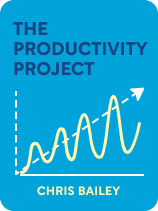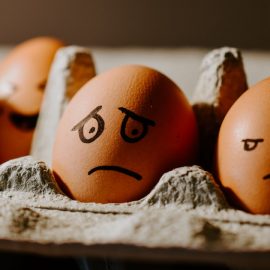

This article is an excerpt from the Shortform book guide to "The Productivity Project" by Chris Bailey. Shortform has the world's best summaries and analyses of books you should be reading.
Like this article? Sign up for a free trial here.
What is Chris Bailey’s The Productivity Project about? What is the key message to take away from the book?
The Productivity Project by Chris Bailey is the culmination of his year-long project to become as productive as possible. Bailey spent the year after graduating from business school researching, writing about, and experimenting with productivity.
Below is a brief overview by The Productivity Project by Chris Bailey.
The Productivity Project
Chris Bailey’s The Productivity Project is a compilation of his conclusions from his “Year of Productivity” experiment and a how-to book for anyone who wants to become more productive and, in doing so, have more time for the things that matter most.
Since embarking on his “Year of Productivity,” Bailey has become recognized as a productivity expert. He’s been invited to speak all over the world, including at major corporations like Google, Amazon, and Microsoft. In addition to publishing numerous articles on productivity, Bailey has also published two additional books on the subject, Hyperfocus and How to Calm Your Mind.
The Productivity Project is organized around 25 productivity strategies that have the potential to be most impactful on your life. Bailey references the work of other productivity experts, like David Allen and Laura Vanderkam, sharing the strategies and advice he’s found most helpful. In this guide, we’ll begin by discussing Bailey’s definition of productivity, then explore practical strategies that can help you become more productive. We’ve organized Bailey’s strategies into the three areas that he says have the biggest impact on your productivity: your time, your focus, and your energy. Throughout the guide we’ll clarify where Bailey has adapted or simplified strategies, and supplement his conclusions with advice from other productivity experts.
What Is Productivity?
In this section, we’ll explain Bailey’s definition of productivity and how it challenges a common misunderstanding about what it means to be productive. We’ll also discuss why you should care about your productivity.
When most people think about being productive, they often think about being busy or getting a lot done. Bailey tweaks this definition, arguing that productivity isn’t about doing a lot, but about doing what matters. For example, if you spent the day responding to a flood of emails, you might feel busy, but it’s unlikely that you made significant progress on anything important.
The ultimate goal of productivity, Bailey explains, is to accomplish meaningful work in less time. However, he doesn’t promote productivity just for the sake of productivity. He argues that you shouldn’t try to be more productive so that you can work more. Instead, he advocates harnessing productivity so you can more effectively reach your goals and gain back valuable free time to pursue what’s most meaningful to you.
But before you start the process of improving your productivity, Bailey recommends getting clear on why you want to be more productive.
Get Clear on Your Why
Bailey argues that in order to successfully become more productive, you must first have a compelling reason. For example, do you want to become more productive so you can feel calmer at work, or so you can spend more time with your family, or so you can finally start writing that romance novel you’ve always talked about? Your why will be an important touch point to come back to as you work on increasing your productivity, and it will help keep you motivated on days when being productive feels especially hard.
To find your why, Bailey recommends writing down your core values and then reflecting on how your values connect to your big-picture goals. How will being more productive help you accomplish these goals? For example, if you value creativity, being more productive will free up time for that garden design project you’ve dreamed of starting.
How Do You Become More Productive?
Now that we’ve defined productivity and explained why it matters, we’ll dig into specific strategies that will help you become more productive on a daily basis
According to Bailey, becoming more productive requires you to effectively manage three things: your time, your attention, and your energy.
Prioritize Your Time
Of the three, you have the least control of your time. Bailey cites author Laura Vanderkam, who writes that everybody only has 24 hours in a day, and 168 hours in a week. There’s no changing the amount of time you have to get things done. What you can control, to some extent, is what you do with that time. In this section, we’ll discuss strategies to make the most of the time you have.
Identify What Is Important
Bailey argues that making the most of your time requires that you first identify your most significant tasks (which he calls “high-impact tasks”). Significant tasks are tasks that are important either because they’re meaningful to you or because they’ll have a big impact on your work. Economic research has shown that 80% of your results usually come from 20% of your effort, a theory known as the Pareto Principle, meaning that a few significant tasks are responsible for the majority of what you accomplish. So logically the more time you spend on your most significant tasks, the more productive you’ll be.
The challenge is to identify what those significant tasks are. To discover your most significant tasks, Bailey suggests a strategy he adapted from Brian Tracy’s Eat That Frog:
- First, list all your professional responsibilities.
- Next, identify the task that brings the most value.
- Finally, identify the other two most important things on the list.
These three items are your most significant tasks.
Bailey recommends planning your day using the “Rule of Three.”
Bailey’s Rule of Three is inspired by J.D. Meier’s recommendation in Getting Results the Agile Way. Like Meier, Bailey suggests that at the beginning of each day and the beginning of each week, you should write down three things you want to accomplish. These three things should be significant tasks that have a big impact on your work and life, but are also doable within the designated time period (day or a week). This will often require breaking down larger projects into smaller, more manageable tasks. Though figuring out the right-size task takes time, with practice you’ll be able to identify the significant tasks that are both manageable and time-appropriate.
At the end of the week, Bailey recommends reviewing the week to reflect on your priorities. He suggests using “the weekly review,” a tool introduced by David Allen in Getting Things Done. In the weekly review, you look back on your tasks and accomplishments from the week to get a big-picture view of what’s going on in your life. The weekly review not only allows you to see what you’ve gotten done but also to plan what’s most important for the following week.
Bailey offers the following questions (adapted from Allen) to help you reflect on your week:
- What needs more of my time, energy, focus?
- What did I spend too much time on?
- What do I need to add to my to-do list?
- Are there any new opportunities?
- Are there any new challenges?
- Am I happy with where I’m going?
Finally, when you have a clear picture of your significant tasks, Bailey recommends spending less time on them instead of more. Working long hours, he explains, is rarely a sign of productivity, but often a sign that you’re not effectively managing your time, focus, and energy. During one productivity experiment, Bailey spent one week working 90 hours and another week working 20. He found that he was barely more productive in his 90-hour work week. When he knew he only had 20 hours to work, he was much more focused. If you give yourself less time on significant tasks, you’ll be more focused and energized with the time you have.
Minimize or Eliminate What Is Unimportant
Effective time management isn’t just about prioritizing what’s most important, but also about minimizing (or eliminating) what isn’t important. For every significant task you have, you probably have at least 20 other insignificant tasks. Insignificant tasks might include anything from checking email to scrolling your company’s social media to attending unnecessarily long meetings. These low-impact, but often still necessary, tasks are a part of almost everybody’s professional and personal life and have the potential to take up large amounts of valuable time.
According to Bailey, every insignificant task can (and should) be removed, outsourced, or consolidated whenever possible. Your time is finite, so the more time you spend on insignificant tasks, the less time you have to spend on the important tasks that will have the biggest impact on your work.
The first step when removing insignificant tasks from your to-do list is to say no. According to Bailey, if something isn’t important, necessary, or meaningful, then you shouldn’t be spending your time doing it. Say no to new requests or opportunities that don’t meet these criteria. To determine whether a task is insignificant, Bailey recommends using the 90% Rule introduced by Greg McKeown in Essentialism. McKeown suggests that every task or opportunity can be rated on a scale of 1-100 based on how valuable or meaningful it is. Anything below a 90, he argues, is unessential and there should be eliminated.
If a task can’t be eliminated, the next step is to consider whether it could be outsourced. To determine whether a task should be outsourced, Bailey recommends asking yourself how much an hour of your time is worth. If it’s worth more than what it would cost to pay someone to do the task, then that task should be delegated. For example, let’s say you value your time at $25/hour. Getting groceries delivered usually costs $10 or less, therefore this would be a logical task to outsource to someone else.
Finally, if insignificant tasks can’t be removed or outsourced, then consolidate them. There are two ways to consolidate insignificant tasks. First, limit the amount of time you spend on insignificant tasks. For example, set time limits for routine meetings, or make sure email replies are as concise as possible. Second, bundle your insignificant tasks to complete them all at once. For example, respond to all your emails at once instead of periodically throughout the day. Bailey also recommends setting aside a full day when you tackle all the insignificant but necessary tasks in your life from laundry to car registration.
While managing your time allows you to make the most of the limited time you have available, Bailey argues that managing your focus and energy is more impactful because they’re more variable, and you have more control over them. In the next two sections, we’ll discuss the importance of your focus and energy.
Hone Your Focus
According to Bailey, multitasking is the enemy of productivity. While working on multiple things at once is stimulating and makes you feel busy, numerous studies have shown that multitasking doesn’t make you more productive.
The key to productivity then is focusing on one thing at a time. Monotasking allows you to invest all your time, attention, and energy into one thing, enabling you to do that one thing better and more efficiently.
To become better at monotasking, Bailey recommends practicing mindfulness—noticing when your attention wanders or when you’re jumping from task to task, then practicing drawing your attention back to the task at hand. You can also practice honing your focus with intentional moments of mindfulness—like actively listening when someone is speaking to you, reading for extended periods of time, or having a daily meditation practice.
Monotasking can also be made easier by clearing up mental space. Bailey explains that if you’re constantly using your brain to try to remember things, then you have less mental space for your significant tasks. Externalizing your ideas allows you to use your brain for coming up with ideas instead of storing them. To get a clear picture of everything that needs to get done, Bailey recommends creating an everything list (which he calls a “brain dump”) where you write down every item you’ve stored in your mental task list, from buying toothpaste to applying for a business loan.
Bailey recommends a couple of ways to organize your everything list (both adapted from Getting Things Done). First, he recommends creating a list that includes anything you’re waiting on—from email responses to Amazon deliveries. He also recommends another list that includes major projects and the next immediate steps you need to take for each project.
Manage Distractions
Monotasking is made even harder by the constant barrage of distractions we encounter in our daily lives. Attention research has shown that employees focus on a project for 11 minutes before being interrupted, and on average it takes them 25 minutes to refocus.
Bailey explains that distractions come in two forms—internal and external. Internal distractions originate in your own mind and can take the form of worries and anxiety, emotional reactions, boredom, hunger, or just unconscious impulses or habits, while external distractions exist outside of us and take the form of phone alerts, emails, or especially chatty colleagues.
External distractions are more straightforward and easier to control. To minimize external distractions, try having designated times when people know you’re focusing and unreachable. Bailey also suggests making the source of external distractions more inconvenient to access. For example, leave your phone in another room, turn off all notifications, or disconnect from the internet entirely if a task allows.
Internal distractions are harder to control because they arise from inside us. Internal distractions, like anxiety or boredom, are often at the root of procrastination. If you’re feeling bored or anxious or overwhelmed, it’s easier to turn away from the task at hand to something simpler and more appealing. It’s especially tempting to procrastinate on your most significant tasks because these tasks are often the most challenging, ambiguous, or frustrating. For example, if you’re feeling anxious about a significant task, you’re more likely to pick up your phone to check the latest notification message or scroll a little longer on Instagram.
When you notice internal distractions leading to procrastination, Bailey recommends asking yourself why and then finding a way to counteract whatever is triggering your procrastination. For example, if a task is boring, go to your favorite bar to get it done. Or if a task is unstructured, create a detailed plan that you’ll follow. And, when all else fails, you can have a go-to procrastination list of necessary insignificant tasks. Then, you can make progress on some of your less important work until you’re ready to focus again.
Find the Balance
While learning how to focus is important, Bailey explains that it’s also important to give your brain a break. Research has shown that the brain fluctuates between two modes—a relaxed mode that’s more introspective and intuitive, and a focused mode that’s deliberate and analytical. Our relaxed brain is good at ideation and creative problem-solving, while our focused brain is great at management and analytical work. Both are important, so the key is to find a balance between the two.
Bailey suggests being intentional about creating time for your mind to drift. Some strategies to flip your brain into relaxed mode include taking a shower, leaving your phone at home, going for a walk, listening to music, or playing sports.
Manage Your Energy
The final step in becoming more productive is managing your energy.
According to Bailey, the amount of energy we have has a dramatic impact on our capacity to be productive. To be your most productive, he argues, you must take care of your body, which means eating well, drinking enough water, getting exercise, and prioritizing sleep.
First, fuel your body with the energy it needs to be productive. Bailey explains that your brain consumes double the energy that other cells in your body consume, so your brain needs healthy fuel to function effectively. He offers two simple rules for eating to optimize your energy—don’t eat more than you need to and eat more unprocessed foods. These two rules will help you manage your glucose levels and avoid an energy crash.
Second, hydrate. Bailey recommends drinking more water, fewer alcoholic or sugary drinks, and using caffeine strategically rather than as a part of your daily routine.
Next, have a consistent exercise routine. It may seem counterintuitive to take time away from work to exercise, but exercise helps you increase productivity by better equipping you to fight stress, increasing blood flow to your brain, combating fatigue, boosting your mood, and even creating new brain cells. According to Bailey, the benefits of exercise far outweigh the lost time.
Finally, prioritize sleep. According to Bailey, lost sleep isn’t worth the productivity cost. Sleep and energy are a simple equation—more sleep means more energy. To ensure you get enough (and high enough quality sleep), Bailey recommends creating routines around your bedtime, including having a nightly ritual that cues your body that it’s time to sleep and limiting screen time at least an hour before bed.
While there’s a lot you can do to control the amount of energy you have, everyone’s energy also naturally fluctuates throughout the day. Referencing the work of Sam Carpenter in Work the System, Bailey explains that every person has times in their day when they have more energy and are primed for focused, high-impact work. Bailey recommends being strategic about when you work, and saving your significant tasks for these periods of peak focus. Your prime focus time is an ideal time to complete your three significant tasks for the day.

———End of Preview———
Like what you just read? Read the rest of the world's best book summary and analysis of Chris Bailey's "The Productivity Project" at Shortform.
Here's what you'll find in our full The Productivity Project summary:
- A how-to book for anyone who wants to become more productive
- Why productivity isn't about doing a lot, but doing what matters
- How to hone your focus and monotask better






